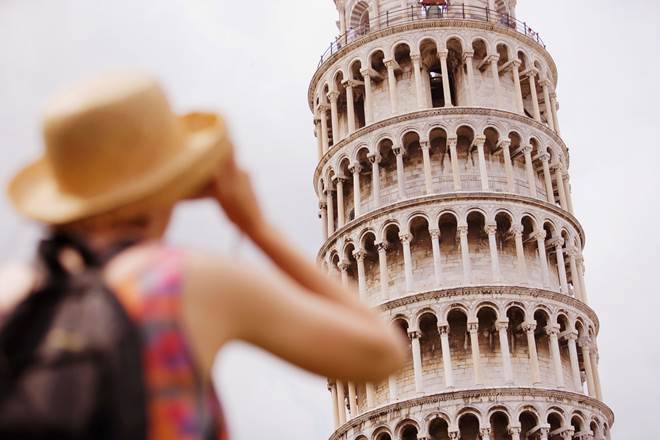Get the straight scoop on Pisa’s tilted sensation. Discover its quirky past, essential facts, and learn how Trainline can help turn your journey into an Italian escapade.
Leaning Tower of Pisa facts: tilting towards intrigue
Let’s set the scene: a tower that’s had one too many limoncellos. It’s Pisa’s own tipsy wonder, an architectural feat that’s been leaning into fame for centuries.
Why is the Leaning Tower of Pisa leaning? Digging the dirt
A bit too soft. The builders, full of gusto in the 12th century, didn’t anticipate that the marshy foundation soil had its own plan — a plan to throw things slightly off-kilter.
Pause & ponder. Construction hit the snooze button for a century, partly hoping the ground might get its act together. Later, the tower’s upper floors were designed to compensate for the tilt.
Modern magic. Fast-forward to the 1990s, and the leaning became a little… extreme. Cue some architectural heroics to ensure that our tower remains the right kind of wonky.
Image Credit: Getty Images, Alexander Hassenstein. Image Location:Pisa, Italy.
Leaning Tower of Pisa history: a twist in the tale
Once envisioned as a strait-laced bell tower, its unexpected swagger transformed it into the ultimate architectural rockstar. Beyond its off-balance allure, the Leaning Tower of Pisa still chimes with several historical gems.
11 need-to-know facts about the Leaning Tower of Pisa
- Bungled from the beginning. The tower began leaning soon after construction started in 1173, due to the soft soil beneath. And it doesn’t just lean; it sinks. Since its construction, the tower has sunk by about 10 feet into the ground. So it wasn’t poor design but rather unfortunate geology.
- Long construction phase. The construction took about 200 years to complete. This prolonged duration was due to numerous wars interrupting the building process.
- Bells with heft. The tower sports seven bells, with the largest one tipping the scales at a whopping 7980 lb. But because of concerns about its stability, they haven’t been rung for years.
- Climbing & conquering. Fancy a panoramic view of Pisa? Trek up the 294 steps. Worth every step (and every calorie burned).
- Mystery architect. For many years, the actual architect of the tower was a mystery. It was only in recent decades that the identity was attributed to Bonanno Pisano.
- Saved by war. During World War II, the tower was almost destroyed. An allied sergeant was sent to confirm if the tower was used by the Germans as an observation post. Captivated by its beauty, he chose not to order an artillery strike.
- Flawed to famous. What was once a building blunder is now a global sensation. An “oops!” turned into a “eureka!”
- Tilt correction. In the 1990s, engineers reduced the tower’s tilt from 5.5 degrees to 3.97 degrees to ensure its safety.
- Snapshot central. Every day, visitors pretend to prop up Pisa in photos. A lean-worthy optical illusion!
- Galileo’s laboratory. The famous scientist Galileo Galilei is believed to have dropped two spheres of different masses from the tower to demonstrate that their descent speed was independent of their mass.
- Steady self. In 2008, after stabilization efforts, experts announced the tower had stopped moving for the first time in its history. Talk about finally settling down!
Image Credit: Getty Images, 1001Love. Image Location: Pisa, Italy.
Lean team
The Leaning Tower might be the A-lister, but Italy boasts other slanted structures.
- Torre delle Milizie, Rome. This ancient tower in Rome has a noticeable lean, believed to be caused by a series of earthquakes.
- Bell tower of San Martino, Burano. This Venetian island, famous for its colorful houses, also has a leaning bell tower that’s hard to miss.
- The Two Towers (Asinelli and Garisenda), Bologna. Both towers sport a signature lean, but Garisenda cranks up the drama. Its evident tilt often earns it head-to-head comparisons with Pisa’s star attraction.
- Bell tower of San Nicola, Pisa. It’s not just the famous tower that leans in Pisa. The bell tower of San Nicola also has a tilt, though it’s less famous than its big brother.
- Campanile del Duomo di Caorle, Venice. This bell tower belongs to the Caorle Cathedral in the Veneto region of Italy and showcases a slight lean.
- Campanile of San Tomaso Cantuariense, Verona. While Verona is famed for Juliet’s balcony, it also houses this leaning bell tower.
Trainline: your ticket to Pisa’s tipsy treasure
Starting your journey in Florence's Santa Maria Novella station, imagine being just a cappuccino’s worth of Tuscany views away from Pisa. Within less than an hour, you’ll find yourself alighting at Pisa Centrale station. And from this point? It’s no more than a jaunty jaunt to that iconic tower.
Pro tip: in the world of travel, waiting is so last season. So, why not pre-book your train journey online and sidestep those not-so-fashionable lines?
Why travel to Pisa by train
- Green glam. Choose trains and give Mother Earth a wink. Classy, quick, and eco-chic.
- Window wonders. As you whisk by, Italy unfolds in a mosaic of vineyards, villas, and valleys.
- Hassle-free hopping. Navigating the Italian rail maze? Trainline’s got your back, ensuring no traveler is left befuddled.
Slant your way to Italy’s off-center marvel. With Trainline as your trusty travel companion, Italy’s romance is a rail ride away.
Header Image Credit: Getty Images, Martin Barraud. Image Location: Pisa, Italy.

